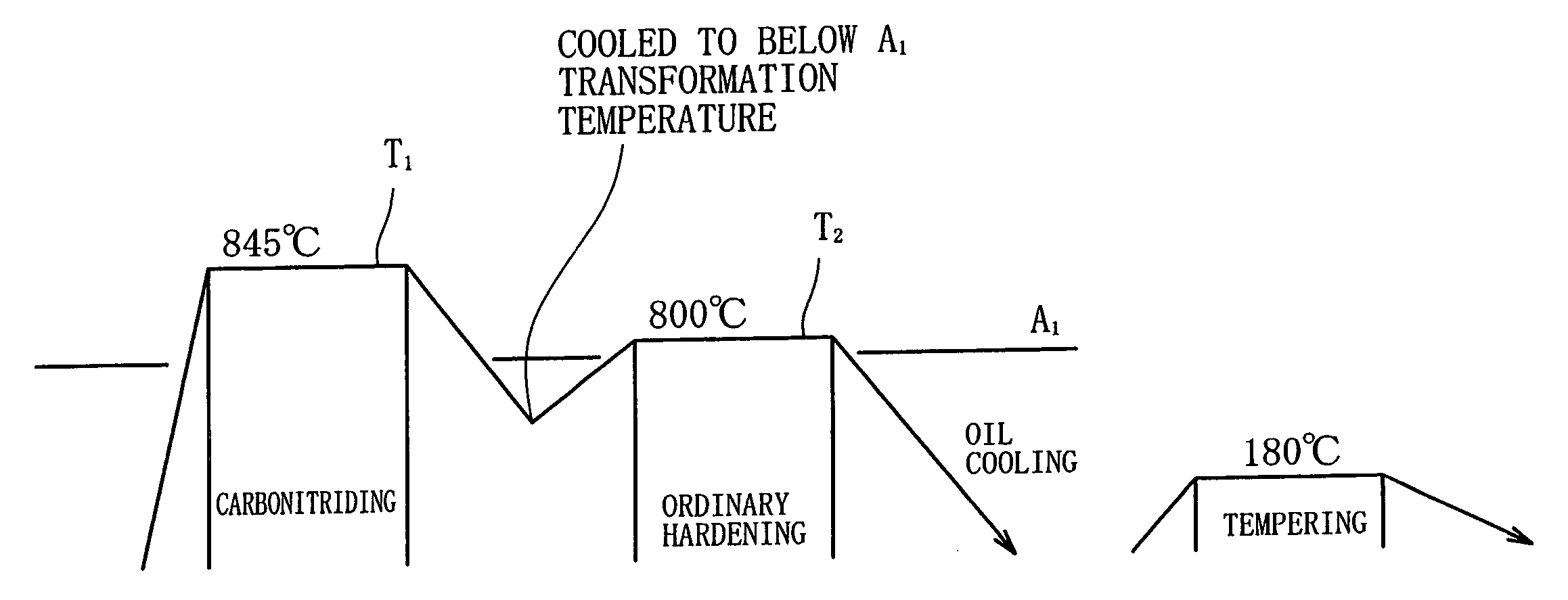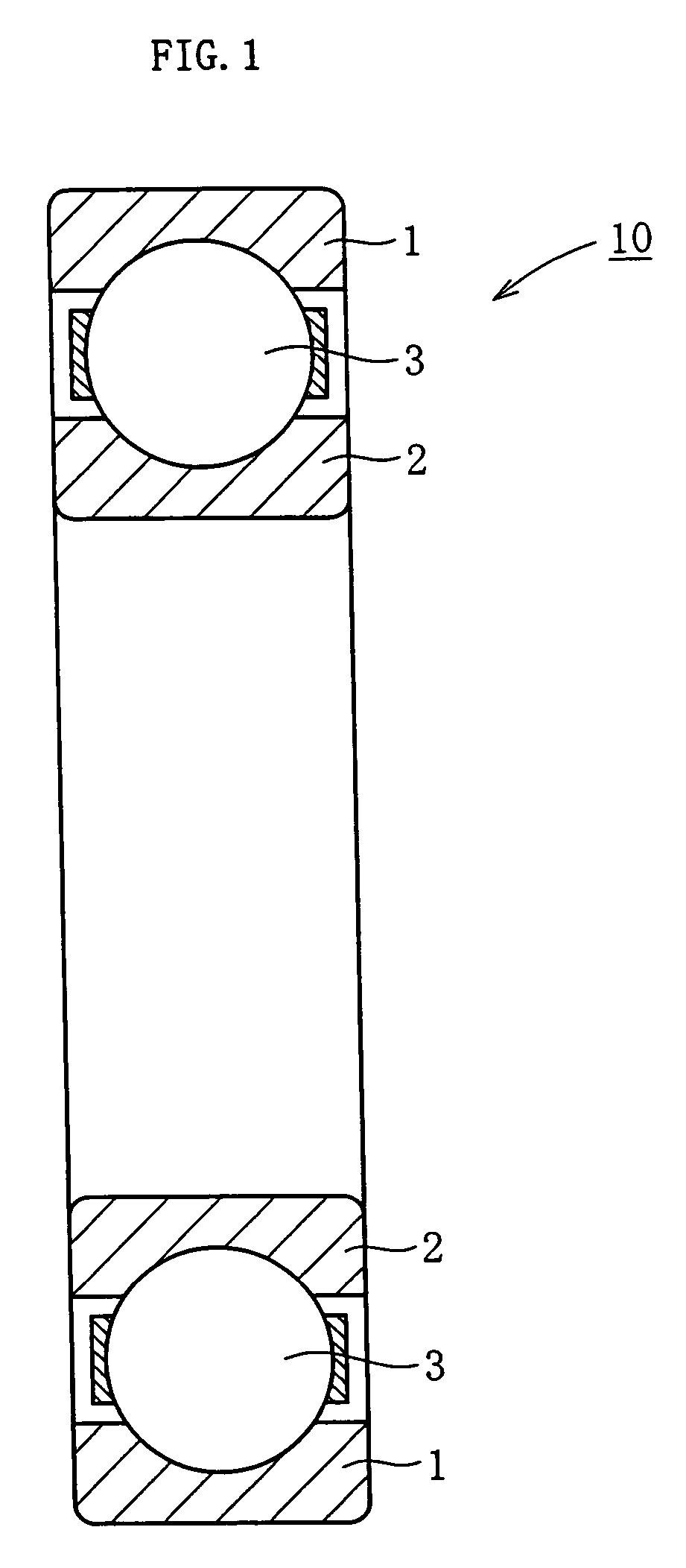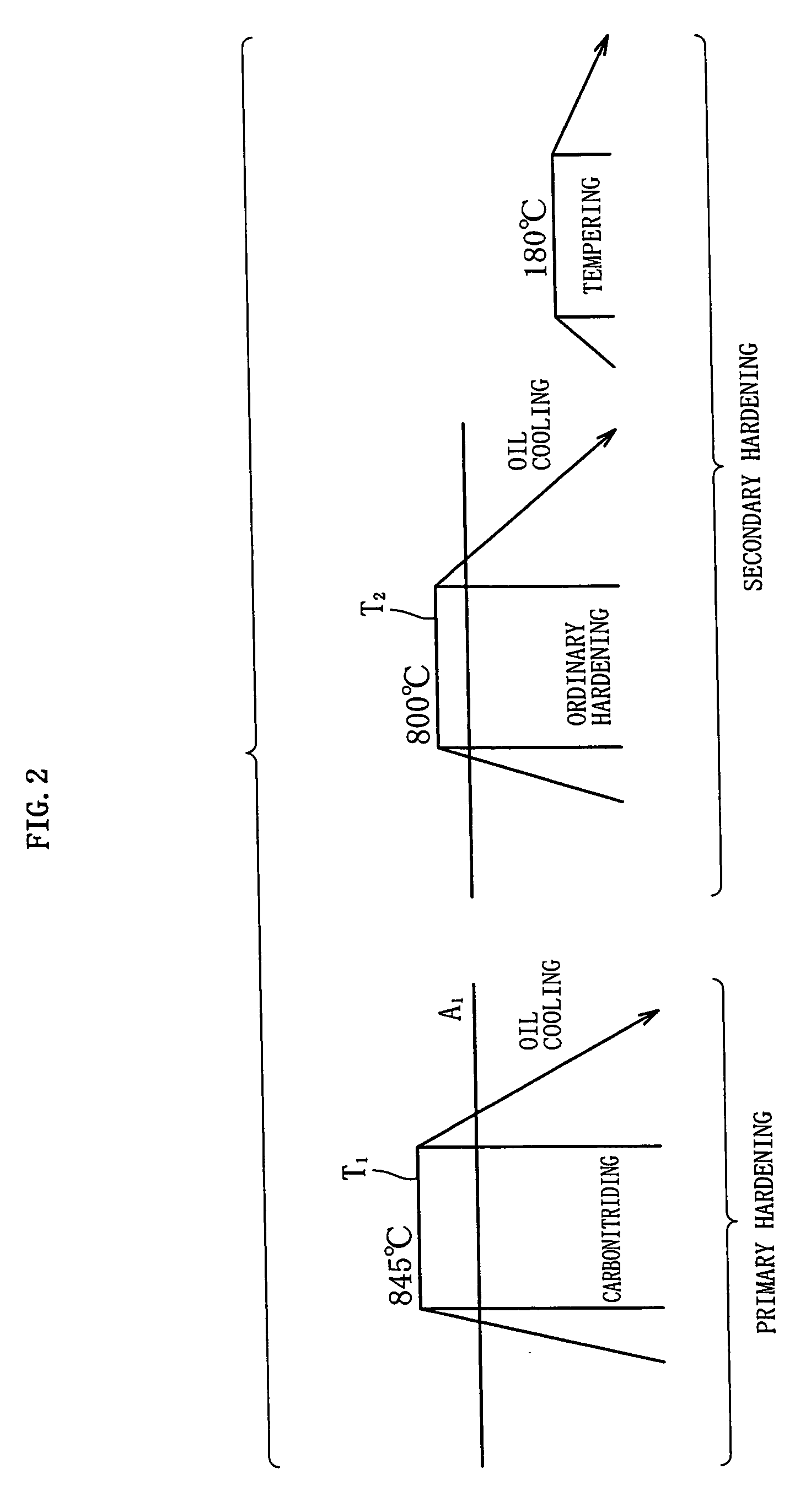Rolling bearing
a rolling bearing and bearing technology, applied in the field of rolling bearings, can solve the problems of loss of hardness or a short life, and it is difficult to obtain a grain size number exceeding 13 and other problems, to achieve the effect of superior rolling fatigue life, high degree of anti-crack strength and dimensional stability
- Summary
- Abstract
- Description
- Claims
- Application Information
AI Technical Summary
Benefits of technology
Problems solved by technology
Method used
Image
Examples
example i
[0029] Using the JIS SUJ2 Material (1.0 wt % C—0.25 wt % Si—0.4 wt % Mn—1.5 wt % Cr), (1) measurement of hydrogen content, (2) measurement of crystal grain size, (3) Charpy impact test, (4) measurement of breaking stress, and (5) rolling fatigue test were performed. Table 1 shows the results.
TABLE 1ConventionalOrdinarySampleABCDEFcarbonitridinghardeningSecondary780800815830850870——hardeningtemperature(° C.)Hydrogen—0.370.400.380.420.400.720.38content(ppm)Crystal—1211.51110101010grain size(JIS)Charpy—6.656.406.306.206.305.336.70impact test(J / cm2)Breaking—2840278026502650270023302770stress(MPa)Rolling—5.44.23.52.92.83.11fatiguelife (L10)Ratio
[0030] The production history of each sample is as follows. Samples A-D (examples of the invention): carbonitriding temperature, 850° C.; the hold time, 150 minutes. The atmosphere was a mixture of RX gas and ammonia gas. In the heat treatment patter shown in FIG. 2, primary hardening is performed from a carbonitriding temperature of 850° C., an...
example ii
[0067] An example II will now be described. A series of test were conducted on the following X-material, Y-material and Z-material. The heat treatment raw material used was JIS SUJ2 MATERIAL (1.0 WT % C—0.25 wt % Si—0.4 wt % Mn—1.5 wt % Cr), applied commonly to the X-material-Z-material. The production histories of the X-material-Z-material are as follows. [0068] X-material (comparative example): ordinary hardening alone (not carbonitrided). [0069] Y-material (comparative example): hardened immediately after carbonitriding (conventional carbonitriding hardening). The carbonitriding temperature was 845° C., and the hold time was 150 minutes. The atmosphere for carbonitriding was RX gas+ammonia gas. [0070] Z-material (example of the invention): a bearing steel subjected to the heat treatment pattern of FIG. 2. The carbonizing temperature was 845° C., and the hold time was 150 minutes. The atmosphere for carbonitriding was RX gas+ammonia gas. The final hardening temperature was 800° C....
example iii
[0093] Table 10 shows the results of tests conducted on the relation between nitrogen content and rolling life under foreign matter mixed-in conditions. In addition, the comparative example 1 is a standard hardened article, and the comparative example 2 is a standard carbonitrided article. The comparative example 3 corresponds to the case in which the same treatment as in the example of the invention is applied but the nitrogen content alone is excessive. The test conditions are as follows. Sample bearing: tapered roller bearing 30206 (the inner and outer rings and rollers are made of high carbon chromium bearing steel class 2 (SUJ2) based on JIS). [0094] Radial load: 17.64 kN. [0095] Axial load: 1.47 kN. [0096] Rotative speed: 2000 rpm.
[0097] Hard foreign matter mixed-in 1 g / L
TABLE 10Rollinglife withforeignAusteniteNitrogenRetainedmattercrystalcontentausteniteHardnessmixed-ingrainNo.(%)(%)(Hv)(h)sizeRemarks10.111472532111.8Example 120.161873537812.0Example 230.182073036211.9Exam...
PUM
| Property | Measurement | Unit |
|---|---|---|
| Fraction | aaaaa | aaaaa |
| Fraction | aaaaa | aaaaa |
| Grain size | aaaaa | aaaaa |
Abstract
Description
Claims
Application Information
 Login to View More
Login to View More - R&D
- Intellectual Property
- Life Sciences
- Materials
- Tech Scout
- Unparalleled Data Quality
- Higher Quality Content
- 60% Fewer Hallucinations
Browse by: Latest US Patents, China's latest patents, Technical Efficacy Thesaurus, Application Domain, Technology Topic, Popular Technical Reports.
© 2025 PatSnap. All rights reserved.Legal|Privacy policy|Modern Slavery Act Transparency Statement|Sitemap|About US| Contact US: help@patsnap.com



